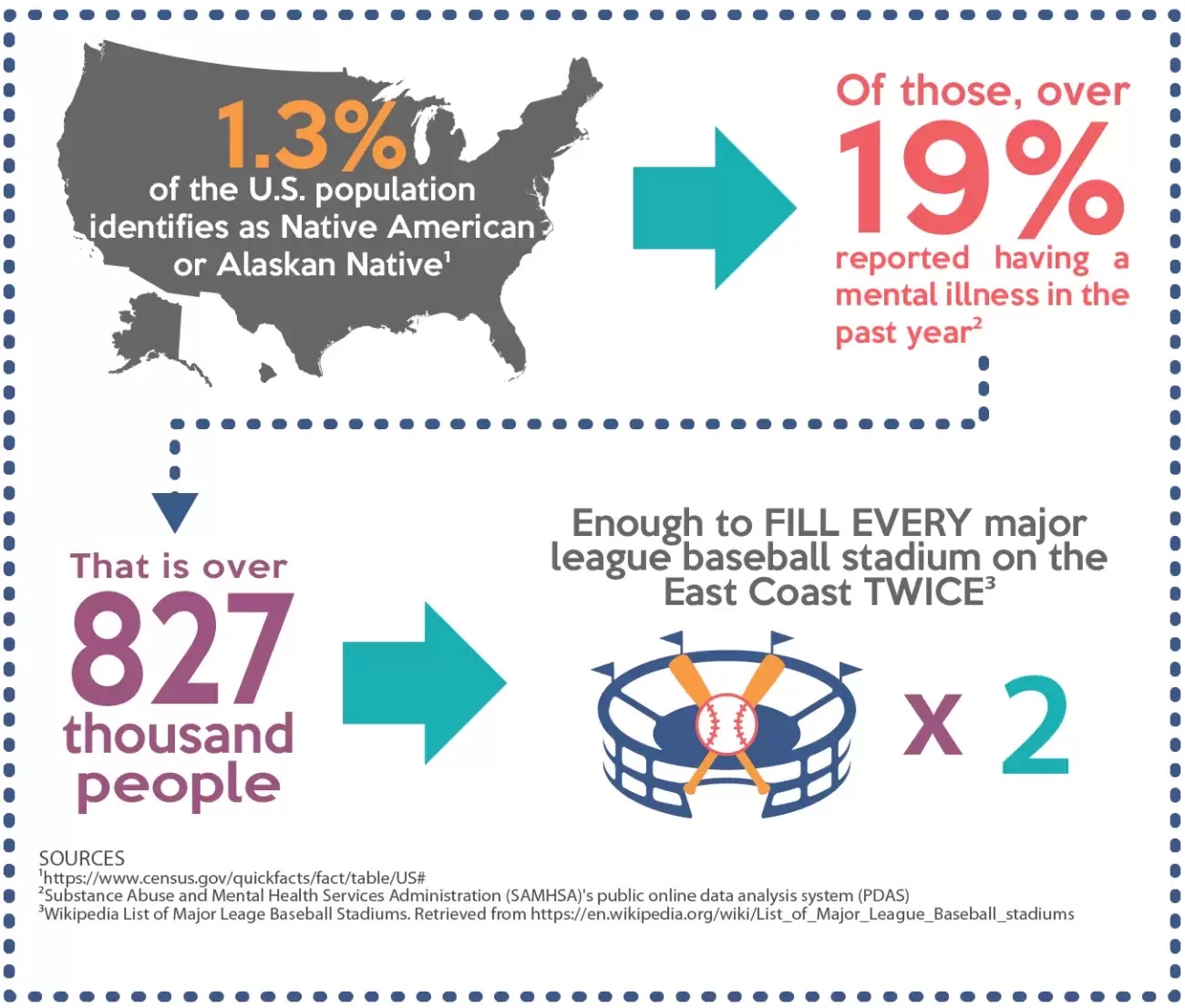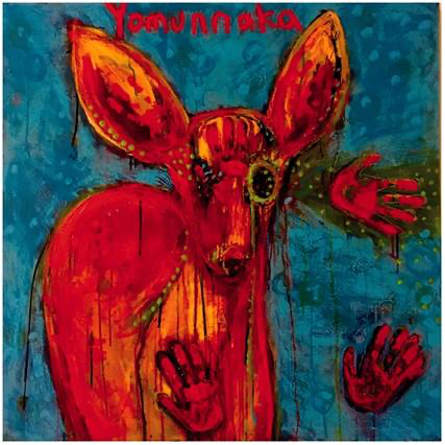Updated November 22, 2022
National Native American Heritage Month is a reminder each year to celebrate Native American people, arts, culture, and heritage. There are 3 million indigenous people in the United States, belonging to 574 federally recognized Indian Nations (variously called tribes, nations, bands, pueblos, communities and native villages) (See map). The majority of American Indians and Alaska Natives (87%) live outside of tribal statistical areas, while 13% live on reservations or other trust lands, according to the 2020 US Census. More than half (60%) of American Indians and Alaska Natives live in metropolitan areas.

Infographic by Mental Health America
Together with our mental health allies and chapters, AATA works to raise awareness about mental health disparities that communities are experiencing.
- Native/Indigenous people report experiencing serious psychological distress 2.5 times more than the general population over a month’s time.
- Although overall suicide rates are similar to those of whites, there are significant differences among certain age groups. The suicide death rate for Native/Indigenous people between the ages of 15-19 is more than double that of non-Hispanic whites.
- Access to mental health services is severely limited by the rural, isolated location of many Native/Indigenous communities. Additionally, access is limited because most clinics and hospitals of the Indian Health Service are located on reservations, yet the majority of Native/Indigenous people in America live outside of tribal areas, according to Mental Health America.
- Nearly 3 times as many Native/Indigenous people (14.9%) had no health insurance, compared to non-Hispanic whites (5.9%). Approximately 43% of Native/Indigenous people in America rely on Medicaid or public coverage, according to HHS.
Many Native/Indigenous tribes embrace a worldview that encompasses the notions of connectedness (with the past and with others), strong family bonds, adaptability, oneness with nature, wisdom of elders, meaningful traditions and strong spirit that may
serve as protective factors when it comes to mental health, according to Mental Health America.
Mental Health Resources For Native And Indigenous Communities
- One Sky Center is a National Resource Center for American Indian and Alaska Native Health, Education and Research. Its mission is to improve prevention and treatment of mental health and substance use problems and services among Native people.
- WeRNative is a comprehensive health resource for Native youth by Native youth, promoting holistic health and positive growth.
- StrongHearts Native Helpline (1-844-762-8483) is a confidential and anonymous culturally-appropriate domestic violence and dating violence helpline for Native Americans, available every day from 7 a.m. to 10 p.m. CT. Or click here to chat online.
- How To Seek Culturally Competent Care by NAMI
- The National Indian Health Board is working to increase awareness of the Behavioral Health needs in Indian Country.
We also want to spotlight:
 The 2019 best paper in Art Therapy: Journal of the American Art Therapy Association: “The Ethical Contemporary Art Therapy: Honoring an American Indian Perspective,” by Michelle Napoli (Access to the Journal is free for all members.)
The 2019 best paper in Art Therapy: Journal of the American Art Therapy Association: “The Ethical Contemporary Art Therapy: Honoring an American Indian Perspective,” by Michelle Napoli (Access to the Journal is free for all members.)
“Yomunnaka Choyyekke/Beautiful Deer” by Michelle Napoli.
“I created Yomunnaka Choyyekke/Beautiful Deer to witness the harm done to my Native community while also honoring our beauty and the fact that we are still here; we still exist. From my worldview regarding historical trauma, what has happened to my ancestors has happened to me: My ancestors’ stories are my stories. Yomunnaka Choyyekke is a personal and culturally informed image of power that teaches me how to witness, grieve, and celebrate with brutal honesty all that is our truth.”
 A profile of Sonsee’rae Sells, an art therapist and clinical counselor at Family Crisis Center in Farmington, New Mexico.
A profile of Sonsee’rae Sells, an art therapist and clinical counselor at Family Crisis Center in Farmington, New Mexico.
“Choosing Battles” by Sonsee’rae Sells. Cardboard and Soda Tabs. May 2018.
Artist’s statement: “Art is a way for me to disconnect from reality momentarily and reconnect to myself. I create art to gain insight about experiences, such as trauma, that are challenging to articulate. The type of skills to make this armor promote an attention to detail, patience, and fine motor abilities. I enjoy tedious sequences like beading and repetition. My armor is a symbolic representation of my experience as a training art therapist.
Practicing Western therapeutic perspectives that contradict my Indigenous values felt like I was challenging what was being taught. Once social justice counseling was introduced at my internship site, I fell in love with being an advocate or social justice warrior. The fiery anger that manifests inside me from unjust historical events makes communicating conflict difficult. I want to continue to practice choosing my battles and strengthen my ability to cope with unfair situations. I also want to incorporate action for change as an art activist. This armor is a reminder to stay true to my values as an American Indian, as a social justice advocate, and as a therapist.”
- In this post, we use terms such as “American Indian” and/or “Alaska Native” when providing information about Indigenous/Native people because the terms accompany statistics listed on this page that have been taken from the original data source. We understand that referring to Indigenous/Native people as “American Indians” can be somewhat misleading, as the term “America” was not used until after colonization. The same can be said about the term “Indian” — it was a name applied by colonizers who mistakenly thought they had arrived in India. Many Indigenous/Native people prefer to use the original nation names that have existed for thousands of years. It is important to remember that prior to the arrival of the first colonists, there were approximately 100 million Indigenous people and thousands of tribes in what is now called the United States.
